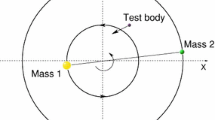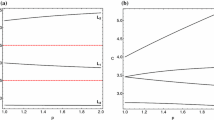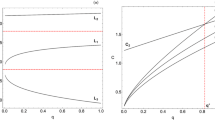Abstract
We numerically investigate the case of the planar circular restricted three-body problem where the more massive primary is an oblate spheroid. A thorough numerical analysis takes place in the configuration \((x,y)\) and the \((x,E)\) space in which we classify initial conditions of orbits into three categories: (i) bounded, (ii) escaping and (iii) collisional. Our results reveal that the oblateness coefficient has a huge impact on the character of orbits. Interpreting the collisional motion as leaking in the phase space we related our results to both chaotic scattering and the theory of leaking Hamiltonian systems. We successfully located the escape as well as the collisional basins and we managed to correlate them with the corresponding escape and collision times. We hope our contribution to be useful for a further understanding of the escape and collision properties of motion in this interesting version of the restricted three-body problem.












Similar content being viewed by others
Notes
We choose the \(\dot{\phi} < 0\) instead of the \(\dot{\phi} > 0\) part simply because in Zotos (2015b) we seen that it contains more interesting orbital content.
An infinite number of regions of (stable) quasi-periodic (or small scale chaotic) motion is expected from classical chaos theory.
References
Abouelmagd, E.I.: Existence and stability of triangular points in the restricted three-body problem with numerical applications. Astrophys. Space Sci. 342, 45–53 (2012)
Altmann, E.G., Portela, J.S.E., Tél, T.: Leaking chaotic systems. Rev. Mod. Phys. 85, 869–918 (2013)
Barrio, R., Blesa, F., Serrano, S.: Is there chaos in Copenhagen problem? Monogr. Real Acad. Ci. Zaragoza 30, 43–50 (2006)
Barrio, R., Blesa, F., Serrano, S.: Fractal structures in the Hénon-Heiles Hamiltonian. Europhys. Lett. 82, 10003 (2008)
Barrio, R., Blesa, F., Serrano, S.: Bifurcations and safe regions in open Hamiltonians. New J. Phys. 11, 053004 (2009)
Beatty, J.K., Petersen, C.C., Chaikin, A.: The New Solar System, 4th edn. Cambridge University Press, Cambridge (1999)
Beevi, A.S., Sharma, R.K.: Oblateness effect of Saturn on periodic orbits in the Saturn-Titan restricted three-body problem. Astrophys. Space Sci. 340, 245–261 (2012)
Benet, L., Trautman, D., Seligman, T.: Chaotic scattering in the restricted three-body problem. I. The Copenhagen problem. Celest. Mech. Dyn. Astron. 66, 203–228 (1996)
Benet, L., Seligman, T., Trautman, D.: Chaotic scattering in the restricted three-body problem II. Small mass parameters. Celest. Mech. Dyn. Astron. 71, 167–189 (1998)
Bleher, S., Grebogi, C., Ott, E., Brown, R.: Fractal boundaries for exit in Hamiltonian dynamics. Phys. Rev. A 38, 930–938 (1988)
Bleher, S., Ott, E., Grebogi, C.: Routes to chaotic scattering. Phys. Rev. Lett. 63, 919–922 (1989)
Broucke, R.A.: Periodic orbits in the restricted three-body problem with Earth-Moon masses. Tech. Rep. 32–1168, Jet Propulsion Laboratory, California Institute of Technology (1968)
Contopoulos, G.: Asymptotic curves and escapes in Hamiltonian systems. Astron. Astrophys. 231, 41–55 (1990)
Contopoulos, G., Kaufmann, D.: Types of escapes in a simple Hamiltonian system. Astron. Astrophys. 253, 379–388 (1992)
Contopoulos, G., Kandrup, H.E., Kaufmann, D.: Fractal properties of escape from a two-dimensional potential. Physica D 64, 310–323 (1993)
de Assis, S.C., Terra, M.O.: Escape dynamics and fractal basin boundaries in the planar Earth–Moon system. Celest. Mech. Dyn. Astron. 120, 105–130 (2014)
de Moura, A.P.S., Grebogi, C.: Countable and uncountable boundaries in chaotic scattering. Phys. Rev. E 66, 046214 (2002)
de Moura, A.P.S., Letelier, P.S.: Fractal basins in Hénon-Heiles and other polynomial potentials. Phys. Lett. A 256, 362–368 (1999)
Ernst, A., Peters, T.: Fractal basins of escape and the formation of spiral arms in a galactic potential with a bar. Mon. Not. R. Astron. Soc. 443, 2579–2589 (2014)
Henon, M.: Numerical exploration of the restricted problem, V. Astron. Astrophys. 1, 223–238 (1969)
Jung, C., Tél, T.: Dimension and escape rate of chaotic scattering from classical and semiclassical cross section data. J. Phys. A 24, 2793–2805 (1991)
Jung, C., Mejia-Monasterio, C., Seligman, T.H.: Scattering one step from chaos. Phys. Lett. A 198, 306–314 (1995)
Jung, C., Lipp, C., Seligman, T.H.: The inverse scattering problem for chaotic Hamiltonian systems. Ann. Phys. 275, 151–189 (1999)
Kalantonis, V.S., Markellos, V.V., Perdios, E.A.: Computing periodic orbits of the three-body problem: effective convergence of Newton’s method on the surface of section. Astrophys. Space Sci. 298, 441–451 (2005)
Kalantonis, V.S., Douskos, C.N., Perdios, E.A.: Numerical determination of homoclinic and heteroclinic orbits as collinear equilibria in the restricted three-body problem with oblateness. Celest. Mech. Dyn. Astron. 94, 135–153 (2006)
Kalantonis, V.S., Perdios, E.A., Perdiou, A.E.: The Sitnikov family and the associated families of 3D periodic orbits in the photogravitational RTBP with oblateness. Astrophys. Space Sci. 315, 323–334 (2008)
Kalvouridis, T., Gousidou-Koutita M.C.: Basins of attraction in the Copenhagen problem where the primaries are magnetic dipoles. Appl. Math. 3, 541–548 (2012)
Kandrup, H.E., Siopis, C., Contopoulos, G., Dvorak, R.: Diffusion and scaling in escapes from two-degrees-of-freedom Hamiltonian systems. Chaos 9, 381–392 (1999)
Markellos, V.V., Papadakis, K.E., Perdios, E.A.: Non-linear stability zones around triangular equilibria in the plane circular restricted three-body problem with oblateness. Astrophys. Space Sci. 245, 157–164 (1996)
Markellos, V.V., Roy, A.E., Velgakis, M.J., Kanavos, S.S.: A photogravitational Hill problem and radiation effects on Hill stability of orbits. Astrophys. Space Sci. 271, 293–301 (2000)
Millis, R.L., Wasserman, L.H., Franz, O.G., et al.: The size, shape, density, and albedo of Ceres from its occultation of BD+8 deg 471. Icarus 72, 507–518 (1987)
Milone, E.F., Wilson, W.J.F.: Solar System Astrophysics Background Science and the Inner Solar System, 2nd edn. Springer, New York (2014)
Moulton, F.R.: An Introduction to Celestial Mechanics, 2nd edn. Dover, New York (1914)
Nagler, J.: Crash test for the Copenhagen problem. Phys. Rev. E 69, 066218 (2004)
Nagler, J.: Crash test for the restricted three-body problem. Phys. Rev. E 71, 026227 (2005)
Nagler, J., Krieger, M., Linke, M., Schönke, J., Jan Wiersig, J.: Leaking billiards. Phys. Rev. E 75, 046204 (2007)
Navarro, J.F., Henrard, J.: Spiral windows for escaping stars. Astron. Astrophys. 369, 1112–1121 (2001)
Norton, O.R., Chitwood, L.A.: Field Guide to Meteors and Meteorites, 1st edn. Springer, London (2008)
Oberti, P., Vienne, A.: An upgraded theory for Helene, Telesto, and Calypso. Astron. Astrophys. 397, 353–359 (2003)
Perdios, A.E., Kalantonis, V.S.: Critical periodic orbits in the restricted three–body problem with oblateness. Astrophys. Space Sci. 305, 331–336 (2006)
Perdiou, A.E., Perdios, E.A., Kalantonis, V.S.: Periodic orbits of the Hill problem with radiation and oblateness. Astrophys. Space Sci. 342, 19–30 (2012)
Poincaré, H.: History of Modern Physics and Astronomy, vol. 13. AIP, New York (1993)
Press, H.P., Teukolsky, S.A., Vetterling, W.T., Flannery, B.P.: Numerical Recipes in FORTRAN 77, 2nd edn. Cambridge University Press, Cambridge (1992)
Schneider, J., Tél, T.: Extracting flow structures from tracer data. Ocean Dyn. 53, 64–72 (2003)
Schneider, J., Tél, T., Neufeld, Z.: Dynamics of “leaking” Hamiltonian systems. Phys. Rev. E 66, 066218 (2002)
Seoane, J.M., Aguirre, J., Sanjuán, M.A.F., Lai, Y.C.: Basin topology in dissipative chaotic scattering. Chaos 16, 023101 (2006)
Seoane, J.M., Sanjuán, M.A.F., Lai, Y.C.: Fractal dimension in dissipative chaotic scattering. Phys. Rev. E 76, 016208 (2007)
Sharma, R.K.: Periodic orbits of the second kind in the restricted three-body problem when the more massive primary is an oblate spheroid. Astrophys. Space Sci. 76, 255–258 (1981)
Sharma, R.K.: The linear stability of libration points of the photogravitational restricted three-body problem when the smaller primary is an oblate spheroid. Astrophys. Space Sci. 135, 271–281 (1987)
Sharma, R.K.: The periodic orbits of the second kind in terms of Giacaglia’s variables with oblateness. Earth Moon Planets 45, 213–218 (1989)
Sharma, R.K.: Periodic orbits of the third kind in the restricted three-body problem with oblateness. Astrophys. Space Sci. 166, 211–218 (1990)
Sharma, R.K., Subba Rao, P.V.: Stationary solutions and their characteristic exponents in the restricted three-body-problem when the more massive primary is an oblate spheroid. Celest. Mech. 13, 137–149 (1976)
Sharma, R.K., Subba Rao, P.V.: Effect of oblateness on triangular solutions at critical mass. Astrophys. Space Sci. 60, 247–250 (1979)
Sharma, R.K., Subba Rao, P.V.: On finite periodic orbits around the equilibrium solutions of the planar restricted three-body problem. In: Bhatnagar, K.B. (ed.) Space Dynamics and Celestial Mechanics, pp. 71–85. Reidel, Dordrecht (1986)
Simó, C., Stuchi, T.: Central stable/unstable manifolds and the destruction of KAM tori in the planar Hill problem. Physica D 140, 1–32 (2000)
Singh, J., Leke, O.: Equilibrium points and stability in the restricted three-body problem with oblateness and variable masses. Astrophys. Space Sci. 340, 27–41 (2012)
Singh, J., Leke, O.: Effect of oblateness, perturbations, radiation and varying masses on the stability of equilibrium points in the restricted three-body problem. Astrophys. Space Sci. 344, 51–61 (2013)
Singh, J., Leke, O.: Motion in a modified Chermnykh’s restricted three-body problem with oblateness. Astrophys. Space Sci. 350, 143–154 (2014)
Stuchi, T.J., Yokohama, A.A., et al.: Dynamics of a spacecraft and normalization around Lagrangian points in the Neptune–Triton system. Adv. Space Res. 42, 1715–1722 (2008)
Subba Rao, P.V., Sharma, R.K.: Oblateness effect on finite periodic orbits at L4. In: 39th Congress of the International Astronautical Federation (IAF-88-300), pp. 8–15 (1988). 6 pages
Subba Rao, P.V., Sharma, R.K.: Effect of oblateness on the non-linear stability of \(L_{4}\) in the restricted three-body problem. Celest. Mech. Dyn. Astron. 65, 291–312 (1997)
Szebehely, V.: Theory of Orbits. Academic Press, New York (1967)
Tuval, I., Schneider, J., Piro, O., Tél, T.: Opening up fractal structures of three-dimensional flows via leaking. Europhys. Lett. 65, 633–639 (2004)
Zotos, E.E.: A Hamiltonian system of three degrees of freedom with eight channels of escape: the great escape. Nonlinear Dyn. 76, 1301–1326 (2014a)
Zotos, E.E.: Revealing the escape mechanism of three-dimensional orbits in a tidally limited star cluster. Mon. Not. R. Astron. Soc. 446, 770–792 (2014a)
Zotos, E.E.: Escapes in Hamiltonian systems with multiple exit channels: part I. Nonlinear Dyn. 78, 1389–1420 (2014b)
Zotos, E.E.: Crash test for the Copenhagen problem with oblateness. Celest. Mech. Dyn. Astron. 122, 75–99 (2015b)
Acknowledgements
I would like to express my warmest thanks to the anonymous referee for the careful reading of the manuscript and for all the apt suggestions and comments which allowed us to improve both the quality and the clarity of the paper.
Author information
Authors and Affiliations
Corresponding author
Rights and permissions
About this article
Cite this article
Zotos, E.E. How does the oblateness coefficient influence the nature of orbits in the restricted three-body problem?. Astrophys Space Sci 358, 33 (2015). https://doi.org/10.1007/s10509-015-2435-z
Received:
Accepted:
Published:
DOI: https://doi.org/10.1007/s10509-015-2435-z




